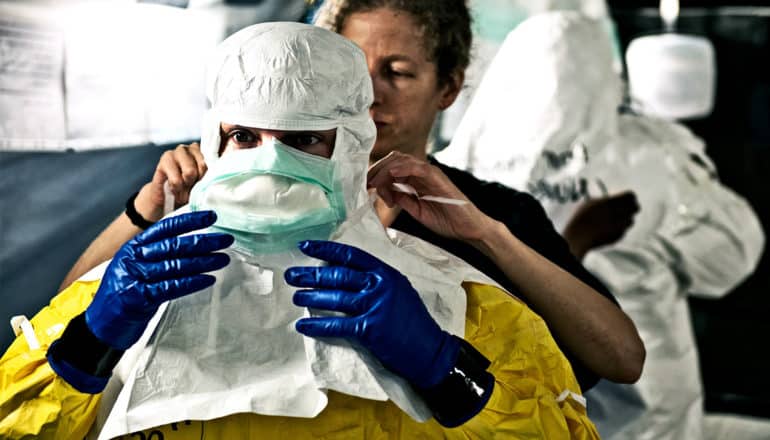
Creating mutations in a key protein that helps Ebola escape the body’s defenses can keep the virus from making its hosts sick and activate protective immunity, researchers report.
The mutated virus even works as a vaccine to protect animals from infection with the Ebola virus, researchers say.
The study suggests that VP35, a protein that enables Ebola virus to block early immune responses to infection, is critical for virulence and is a potential drug target.
Zaire ebolavirus, a member of the filovirus family, is a dangerous pathogen that causes outbreaks of severe, often lethal, disease in humans. A 2013-16 epidemic affected more than 28,000 people and resulted in more than 11,000 deaths, with cases spreading from West Africa to Europe and the United States. Outbreaks in the Democratic Republic of the Congo from 2018 to the present have resulted in nearly 1,800 deaths and emphasize the importance of understanding the factors that contribute to the virulence of the virus.
The researchers have been studying VP35 for a while, and in previous work they discovered the protein is fundamental in blocking innate immune responses to Ebola virus infections.
A mutant Ebola virus
In this study, the researchers wanted to determine how VP35 affects Ebola virus disease and host immune responses in animals that most closely resemble human disease. They built mutations into VP35 to create a mutant Ebola virus that was viable and could grow in cell culture. While most current vaccine candidates express a single Ebola virus protein, this mutant virus expresses all of the Ebola virus genes and has the structure of an actual Ebola virus particle.
This mutant virus poses a decreased risk for scientists and shows mutant viruses could be useful for safely studying many Ebola virus functions.
The researchers found that Ebola virus with a mutated VP35 induces immune responses that are strong enough to protect non-human primates from infection with wildtype Ebola virus. VP35 mutant viruses have been studied in other animals, such as mice and guinea pigs, but these animals aren’t the best model for Ebola virus disease.
Administering 1,000 infectious units of wildtype Ebola virus would result in 100% mortality. Because the researchers expected the mutant virus to be less able to cause disease, they gave non-human primates 20,000 infectious units of the mutant virus and the animals didn’t become ill.
Manipulating the immune system
“We think that VP35 is affecting immune responses overall, so after giving this virus that doesn’t cause disease, we thought maybe it will protect animals if you challenge them with the wildtype Ebola virus,” says senior author Christopher Basler, director of the Center for Microbial Pathogenesis and a professor in the Institute for Biomedical Sciences at Georgia State University.
The researchers challenged non-human primates who had previously received the mutant virus with 1,000 infectious units of wildtype Ebola virus. Two of the animals showed no signs of disease. They administered 300,000 infectious units of the mutant virus and challenged the non-human primates with wildtype Ebola virus. The animals developed a robust immune response to the mutant virus and didn’t exhibit the inflammation and mortality found in normal Ebola virus infections.
“They were completely protected. None of them showed any sign of disease to the parental virus,” Basler says. “The big take home message is that we can make an Ebola virus that grows, but if we disable this function, we can now make a virus that is very highly attenuated in the animals. I think that says that the VP35 protein really does manipulate the immune system to allow the virus to grow to cause disease. This function of VP35 would be a good target for therapies if we find a drug that would disable that function.”
In the future, the researchers would like to show that this approach could be used to weaken other members of the filovirus family, such as Marburg virus.
The findings are published in the journal Cell Reports.
Additional coauthors of the study came from the University of Texas Medical Branch; the University of California, Irvine; and Georgia State University.
Funding for the study came from the National Institutes of Health’s National Institute of Allergy and Infectious Diseases.
Source: Georgia State University
The post Adding a mutation to Ebola could sap its infectious power appeared first on Futurity.
from Futurity https://ift.tt/31GNWs2
No comments:
Post a Comment